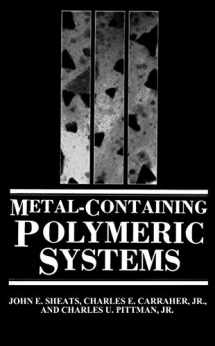
Metal-Containing Polymeric Systems
ISBN-13:
9780306418914
ISBN-10:
0306418916
Edition:
1985
Author:
Charles E. Carraher Jr., Charles U. Pittman, John E. Sheats
Publication date:
1985
Publisher:
Springer
Format:
Hardcover
534 pages
FREE US shipping
Book details
ISBN-13:
9780306418914
ISBN-10:
0306418916
Edition:
1985
Author:
Charles E. Carraher Jr., Charles U. Pittman, John E. Sheats
Publication date:
1985
Publisher:
Springer
Format:
Hardcover
534 pages
Summary
Metal-Containing Polymeric Systems (ISBN-13: 9780306418914 and ISBN-10: 0306418916), written by authors
Charles E. Carraher Jr., Charles U. Pittman, John E. Sheats, was published by Springer in 1985.
With an overall rating of 4.2 stars, it's a notable title among other
books. You can easily purchase or rent Metal-Containing Polymeric Systems (Hardcover) from BooksRun,
along with many other new and used
books
and textbooks.
And, if you're looking to sell your copy, our current buyback offer is $0.3.
Description
Research on metal-containing polymers began in the early 1960's when several workers found that vinyl ferrocene and other vinylic transition metal u -com plexes would undergo polymerization under the same conditions as conventional organic monomers to form high polymers which incorporated a potentially reactive metal as an integral part of the polymer structures. Some of these materials could act as semi-conducters and pos sessed one or two dimensional conductivity. Thus appli cations in electronics could be visualized immediately. Other workers found that reactions used to make simple metal chelates could be used to prepare polymers if the ligands were designed properly. As interest in homo geneous catalysts developed in the late 60's and early 70's, several investigators began binding homogeneous catalysts onto polymers, where the advantage of homo geneous catalysis - known reaction mechanisms and the advantage of heterogeneous catalysis - simplicity and ease of recovery of catalysts could both be obtained. Indeed the polymer matrix itself often enhanced the selectivity of the catalyst.


We would LOVE it if you could help us and other readers by reviewing the book
Book review

Congratulations! We have received your book review.
{user}
{createdAt}
by {truncated_author}


